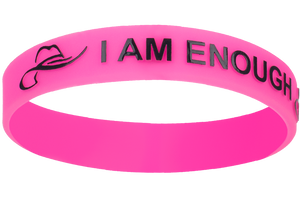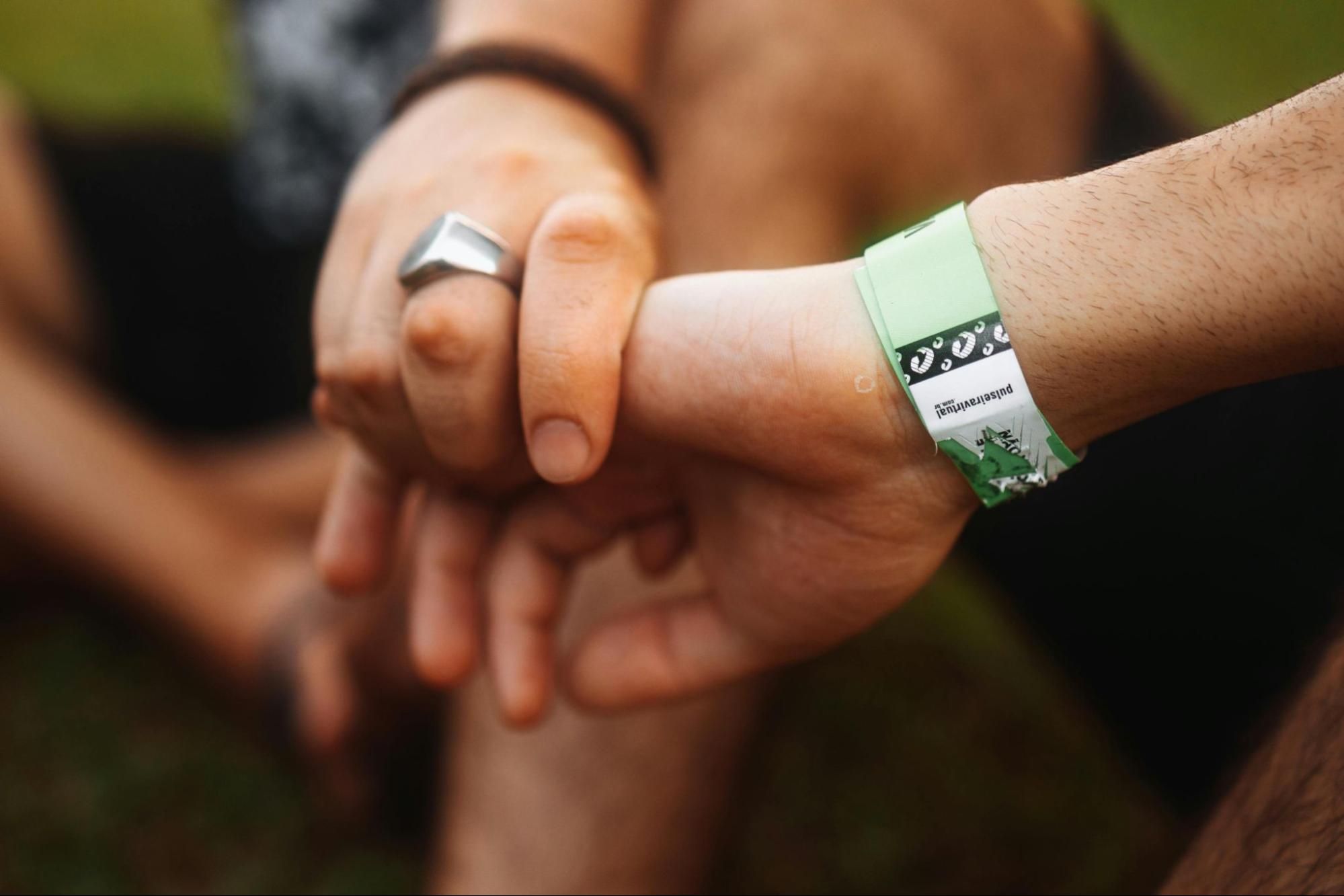Choosing the correct wristband size can significantly contribute to comfort and functionality. The right wristband fit ensures optimal performance and enhances wearability. However, wristband sizes can vary significantly by style, manufacturer, materials used, and the intent behind their use.
This guide will be essential for choosing the perfect wristband size.
Materials Used in Wristband Manufacturing
Among the diverse assortment of materials employed in wristband fabrication, some of the most prevalent include silicone, fabric, plastic, neoprene, and metal.
Silicone. Recognized for its outstanding elasticity and durability, silicone is typically chosen for its water and heat-resistant properties. However, its breathability might be lower than the fabric.
Fabric. Fabric or polyester wristbands are commonly seen at events, offering superb comfort, breathability, and incredible versatility. However, their durability could vary depending on the type of fabric used.
Plastic. While boasting impressive resilience to water and impacts and being cost-effective, plastic wristbands may not provide the same comfort and flexibility for long-term wear.
Neoprene. A neoprene wristband is made from a soft, durable material called neoprene, often used in wetsuits. Neoprene is highly resistant to water, heat, and weathering, making it a durable wristband. These comfortable and flexible wristbands suit many applications, including sports and fitness activities. They’re also popular as promotional items as they can easily be customized with colors, logos, and designs.
Metal Clip. A wristband with a metal clip is often called a snap or clasp wristband. The material that surrounds it varies depending on the type and use of the wristband. Fabric or synthetic materials like silicone or neoprene are commonly used in crafting these wristbands.
Ultimately, the ideal choice of wristband material largely depends on the user’s specific needs, preferences, and the intended function. Balancing durability, comfort, and flexibility is crucial to effectively cater to diverse customer demands.

Sizing for Different Wristband Types
Different types of wristbands often come with their specific sizing considerations. Understanding the size and fit of each type will ensure maximum comfort and functionality.
Elastic bands. These types often stretch to fit most wrist sizes without resizing.
Silicone. Similar to elastic bands, silicone wristbands are stretchable. Yet, they often offer more endurance and maintain their shape and size over time better.
Fabric. These wristbands typically come with adjustable locks or clasps, which enable users to resize easily depending on their wrist circumference.
Plastic/Vinyl. Most plastic/vinyl wristbands are designed one-size-fits-all with adjustable snap closures or peel-off adhesive tabs.
Standard Wristband Sizes
Wristband sizes primarily correspond to the circumference of the individual’s wrist. They are typically categorized into small, medium, and large for adults, with additional categories for children and infants in some cases.
Here is a comparison table showcasing the generally accepted measurements for these categories:
These are general guidelines only. Actual sizes may vary slightly depending on the manufacturer, the type of wristband, and the material it’s made from.
How to Measure Your Wrist for a Perfect Fit
Here’s a quick guide to measuring your wrist size:
Find a measuring tape. A flexible cloth tape measure is the most accurate tool. If a cloth tape measure isn’t available, a strip of paper or string and a ruler can also work.
Position your wrist. Extend your arm forward, with your palm facing up. Relax your wrist and hand.
Get your wrist size. Wrap the tape around your wrist, just below the wrist bone toward your hand. This is usually where you’d wear a wristband. Make sure the tape is wrapped snugly. It should be able to move freely around your wrist without any problems.
Read the measurement. The point where the measuring tape overlaps or meets is your wrist size. If using a string or strip of paper, mark this point, then match it against a ruler to get your measurement. Record the measurement in inches or centimeters, as needed.
Size accordingly. Now, you can match this measurement with the relevant wristband size guide for the best and most comfortable fit.
Consider ease. Depending on the type of wristband and its usage, you might want to add a buffer for movement.
Wristband Thickness
Wristband thickness varies depending on the material of the wristband. Here's a section detailing the thickness of different wristbands:
Silicone wristbands, including those equipped with metal clips, are available in various thicknesses such as 1/4, 1/2, 1, and 1.5 inches.
Tyvek, vinyl, and plastic wristbands typically come with a 3/4-inch or 1-inch thickness.
Fabric and neoprene wristbands, commonly used for sporting activities and extended events, typically come in thicknesses ranging from 1/2 to 1 inch.
Remember that the thickness of wristbands can vary based on the manufacturers and the specific design of the wristbands. It's also important to consider if the wristbands are for single-use events, such as concerts or festivals, or more prolonged usage, such as for medical purposes or to show support for a cause.
Different uses can also factor into the thickness and overall design of the wristbands. The priority is typically on comfort and durability, but these can be achieved with various thicknesses across the different types of wristbands.
Problems and Risks of Incorrect Wristband Size
Wearing a wristband with an improper fit can lead to multiple issues depending on its purpose. An ill-fitting wristband can drastically impact the wristband's functionality and lead to skin problems.

Skin Problems
Wearing a wristband that isn’t the right size could lead to skin irritation, excessive sweating, rashes, or even sores, particularly in the case of rough or rigid materials or extreme weather conditions. Wearing a too-tight wristband can constrict the skin, leading to friction that causes blisters. But a too-loose wristband can constantly move around, rubbing against the skin all day, leading to irritation.
Inaccuracy of Information
The clarity of information engraved on wristbands, such as for medical ID bands, is essential. If the wristband size is not suitable or the quality is not up to the mark, it may result in faster wear and tear. More so, regular friction could gradually erode the engraved text over time. This could compromise the clarity of crucial medical information and lead to avoidable confusion or minor delays in treatment.
Wristbands Cost
Pricing for wristbands can vary widely depending on several factors:
Material
Brand
Quantity
Customization
Additional features
Additional features such as RFID technology, glow-in-dark, UV color changing, or embossed patterns will add to the cost.
Here is a general cost comparison table based on material, without any additional customization:
Note: This data is based on our price chart per wristband type and a purely indicative range. Price changes depending on quantity per type.
Aside from the primary factors affecting wristband costs—material, brand, quantity, and customization—other contributing elements are worth considering. For instance, the level of intricacy involved in the design can significantly impact the price. More complex or intricate designs necessitate more resources for execution, subsequently raising costs.
Order size also plays a significant role; bulk orders often attract substantial discounts, while smaller orders may lead to higher unit costs due to the fixed costs related to production setup and material procurement.
Furthermore, lead time or the urgency of the order can affect pricing—with rush orders typically incurring additional costs to expedite production and delivery.
Ultimately, while the cost range table provides a valuable benchmark to stimulate understanding and guide expectations, it’s imperative to note that the actual costs may fluctuate based on many variables, including the fluctuating costs of raw materials and labor in different regions. Always consult providers for an accurate quotation that suits your needs and budget constraints.
Wrapping Up
When ordering wristbands, the correct size is pivotal for comfort and function. We aimed to provide a comprehensive guide to understanding and determining the appropriate wristband size. Regardless of their intended use, the convenience of wristbands should not be compromised by poor fit.
Recognizing the importance of wristband size and measuring your wrist accurately can lead to a vastly improved wristband-wearing experience. Whether partaking in a mass event, engaging in physical activities, accessorizing, or just aiming for comfortable everyday wear, the right wristband size is vital to the optimal wristband experience.
For more wristband information, visit our FAQs section or call us to address your queries.
/filters:quality(80)/fit-in/630x380/blog/image-1702519155.jpg)